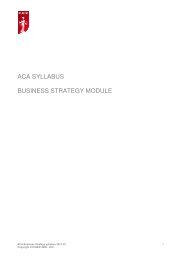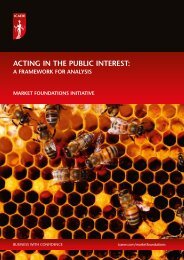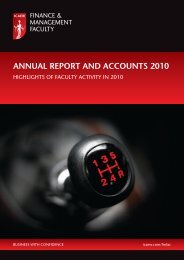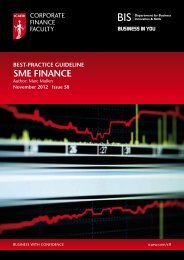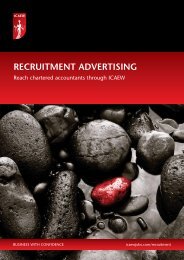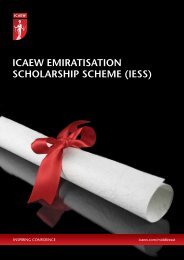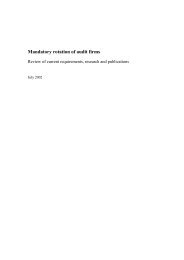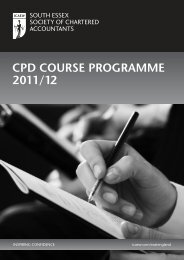Barkess <strong>and</strong> Simnett (1994), using a much larger sample of 2,094 observations ofAustralian data, find no relationship between NAS provision <strong>and</strong> the type of <strong>audit</strong>report issued. Craswell (1999) does not find a link either.Sharma <strong>and</strong> Sidhu’s (2001) study focuses on 49 Australian companies facingimminent bankruptcy. He investigates whether the proportion of NAS to total fees isassociated with the propensity to issue a going concern qualification in the yearpreceding bankruptcy. It is argued that this is a more appropriate context for study. Ithelps to rule out the possibility that the absence of a going concern qualification arisesbecause the <strong>audit</strong>or believes that the NAS will allow management to successfully turnthe company (p.619). A positive relationship is found, suggesting that higher NASfees reduce the likelihood that a qualified report will be issued, a finding attributed toimpaired <strong>audit</strong>or <strong>independence</strong>. The same study is reported in another paper (Sharma(2001).Craswell, Stokes <strong>and</strong> Laughton (2002) explore the link between <strong>audit</strong>or <strong>independence</strong><strong>and</strong> fee dependence at the local office level. Previous studies have shown that thethreats to <strong>independence</strong> are perceived to be more extreme at the office level than thefirm level (Beattie et al., 1999). While their study focuses on the effects of <strong>audit</strong> feedependence, the effects of NAS fee dependence are controlled for. They find noevidence that the level of fee dependence affects the <strong>audit</strong>or’s propensity to issueunqualified <strong>audit</strong> opinions. 259.3 Evidence from <strong>audit</strong> failuresAntle, Griffin, Teece <strong>and</strong> Williamson (1997), in a report prepared on behalf of theAICPA, find that in only 3 of the 610 claims against US <strong>audit</strong>ors were thereallegations that <strong>independence</strong> was somehow impaired by the supply of NAS (reportedin Arruñada, 1999b, p.519).Using an overlapping data set, Palmrose (2000) found that less than 1% of thelawsuits against <strong>audit</strong>ors in the US between 1960 <strong>and</strong> 1995 (numbering over 1,000)included an allegation involving the provision of NAS.9.4 Summary <strong>and</strong> commentsClearly the evidence regarding a link between NAS fees <strong>and</strong> the propensity to issue aqualified opinion is mixed. A few studies do find a link (Wines, 1994; Sharma, 2001),whereas most do not (Barkess <strong>and</strong> Simnett, 1994; Craswell, 1999; DeFond et al,2002; <strong>and</strong> Craswell et al., 2002). To be valid, it is important that the <strong>audit</strong> opinionmodels being estimated are well-specified <strong>and</strong> that there are no omitted variables thatinfluence the decision. There is a great danger of self-selection bias is these studies, inthat the circumstances of client companies that acquire <strong>non</strong>-<strong>audit</strong> <strong>services</strong> may well besystematically different from those who do not. For these reasons, even in cases wherean association is observed, it cannot readily be interpreted as <strong>audit</strong>ors compromisingtheir <strong>independence</strong> to retain high NAS fees. Finally, joint service provision has notfeatured as a significant factor in litigation against <strong>audit</strong>ors.25 Reynolds <strong>and</strong> Francis (2001) examine the issue of economic dependence <strong>and</strong> the propensity to issuea going concern <strong>audit</strong> report at the office level for US companies. Economic dependence is measuredusing client company sales data <strong>and</strong> no link is found. Since NAS fees are not used, however, theimplications for NAS provision are unclear.55
CHAPTER 10EVIDENCE OF ASSOCIATION BETWEEN NAS FEES AND EARNINGSQUALITY10.1 IntroductionUntil very recently, there were no studies that examined whether the provision ofNAS impacts upon the attributes of accounting numbers. The absence of publishedNAS fee data in the US until recently is one reason for this. In the last two years,several (mostly as yet unpublished) papers have explored the link between earningsquality (or earnings conservatism or earnings management) <strong>and</strong> NAS. Earningsquality is, in part, a function of <strong>audit</strong>or <strong>independence</strong>.10.2 Earnings management <strong>and</strong> the measurement problemThe academic <strong>and</strong> professional literature offers a variety of definitions of earningsmanagement. A typical recent offering is ‘earnings management occurs whenmanagers use judgment in financial report <strong>and</strong> in structuring transactions to alterfinancial reports to either mislead some stakeholders about the underlying economicperformance of the company or to influence contractual outcomes that depend onreported accounting numbers’ (Healy <strong>and</strong> Wahlen, 1999, p.368).The earnings figure emerges from the application of accrual accounting, by applyingaccounting principles for revenue recognition <strong>and</strong> the matching of expenses withrevenue. The main reason for reporting earnings figures (in addition to cash flows) isto help investors assess the performance of the company, generally by smoothingreported earnings. However, given managerial incentives <strong>and</strong> the existence ofdiscretion in applying accounting principles, there is concern that companies are usingsuch practices to ‘stash accruals in cookie jars during good times <strong>and</strong> reach into themwhen needed in the bad times’ (Levitt, 1998). The key question, posed by (Dechow<strong>and</strong> Skinner, 2000) is: when does the appropriate exercise of managerial discretionbecome earnings management?Studies of this type require a measure of earnings management activity <strong>and</strong> the mostcommon approach is to use a measure of discretionary accruals 26 as a proxy for this.Discretionary accruals are measured using the Jones (1991) model or a variantthereof. To estimate discretionary accruals, studies first identify total accruals,measured as the difference between reported net income <strong>and</strong> cash flows fromoperations. Total accruals is then regressed on variables (such as revenues <strong>and</strong> grossfixed assets) that would explain the normal level of accruals. Discretionary accrualsthen emerge as the residuals from the regression model.10.3 Empirical studies10.3.1 US studiesChung <strong>and</strong> Kallapur (2001) make use of the recent NAS fee disclosure requirementsto investigate the link between client importance <strong>and</strong> abnormal accruals (estimatedusing the modified Jones model). Client importance is measured as the ratio of clientfees to <strong>audit</strong> firm’s total US revenues <strong>and</strong> also as the ratio of client <strong>non</strong>-<strong>audit</strong> fees to<strong>audit</strong> firm’s total US revenues. After controlling for other variables that influence26 Also termed unexpected or abnormal accruals.56
- Page 5 and 6:
LIST OF TABLESPage3.1 Definitions a
- Page 7 and 8:
LIST OF ABBREVIATIONSACCAAICPAAPBAR
- Page 9 and 10:
Auditor Independence and Non-audit
- Page 11 and 12:
2.2 Current regulatory frameworks:
- Page 13 and 14:
There is limited evidence that, in
- Page 15 and 16:
firms have, over the last 10 years,
- Page 17 and 18: CHAPTER 2AUDITOR INDEPENDENCE2.1 In
- Page 19 and 20: low cost strategies to protect and/
- Page 21 and 22: • the costs of auditor switching
- Page 23 and 24: Johnstone, Sutton and Warfield (200
- Page 25 and 26: estrictive. Nevertheless, these stu
- Page 27 and 28: 3.3 Independence in professional an
- Page 29 and 30: Table 3.1 (cont.): Definitions and
- Page 31 and 32: followed by a detailed set of rules
- Page 33 and 34: Provision of some of these services
- Page 35 and 36: There is a significant self-review
- Page 37 and 38: of taking management decisions, sel
- Page 39 and 40: pieces. While a few research-relate
- Page 41 and 42: CHAPTER 5DESCRIPTIVE STUDIES OF NAT
- Page 43 and 44: Ezzamel, Gwilliam and Holland (2002
- Page 45 and 46: Parkash and Venable’s (1993) stud
- Page 47 and 48: CHAPTER 7IMPACT OF JOINT PROVISION
- Page 49 and 50: affirmative to five type of service
- Page 51 and 52: McKinley, Pany and Reckers (1985) u
- Page 53 and 54: NAS and audit fees regardless of th
- Page 55 and 56: 7.3.5 New Zealand studiesGul (1989)
- Page 57 and 58: support those of Corless and Parker
- Page 59 and 60: CHAPTER 8ASSOCIATIONS BETWEEN JOINT
- Page 61 and 62: an independent variable in the audi
- Page 63 and 64: Ezzamel, Gwilliam and Holland (2002
- Page 65 and 66: 8.7 Auditor tenure and auditor chan
- Page 67: CHAPTER 9EVIDENCE OF ASSOCIATION BE
- Page 71 and 72: 10.3.3 Australian studiesGul and Ts
- Page 73 and 74: the frameworks are generally imprec
- Page 75 and 76: publicly available data of relevanc
- Page 77 and 78: Antle, R. and Demski, J.S. (1991),
- Page 79 and 80: Craswell, A.T., Stokes, D.J. and La
- Page 81 and 82: Frankel, R.M., Johnson, M.F. and Ne
- Page 83 and 84: Jeppesen, K.K. (1998), ‘Reinventi
- Page 85 and 86: O’Sullivan, N. and Diacon, S.R. (
- Page 87 and 88: Schuetze, W.P. (1994), ‘A Mountai




